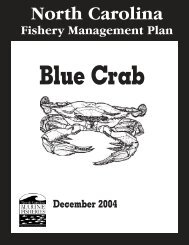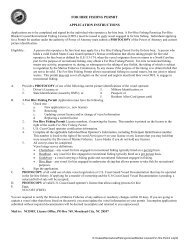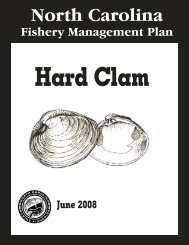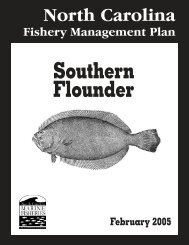Striped Mullet FMP - NC Dept. of Environment and Natural Resources
Striped Mullet FMP - NC Dept. of Environment and Natural Resources
Striped Mullet FMP - NC Dept. of Environment and Natural Resources
You also want an ePaper? Increase the reach of your titles
YUMPU automatically turns print PDFs into web optimized ePapers that Google loves.
surveys provided indices <strong>of</strong> adult CPUE <strong>and</strong> length compositions, <strong>and</strong> two seine surveys servedas juvenile abundance indices (JAI).ResultsBased on the population model results, the three highest estimates <strong>of</strong> age 0 recruitment(R 0 ) have occurred in the most recent five years, peaking in 2002. High yearly levels <strong>of</strong> R 0 arecharacteristic for the stock, averaging 61 million new recruits per year. Female spawning stockbiomass (SSB) has increased from 1994 to 2002, with peak SSB occurring over the last threeyears <strong>of</strong> the assessment.Fishing mortality (instantaneous rate, F) was estimated separately for the recreational<strong>and</strong> commercial fisheries, notated as F r <strong>and</strong> F c . Fishing mortality was also estimated for eachJanuary-June <strong>and</strong> July-December period, referred to as F c Jan <strong>and</strong> F c Jul , as examples. Full yearfishing mortality is the sum <strong>of</strong> the seasonal F rates within a year, written as F r Tot or F c Tot .Only minor recreational fishing mortality (F r ) is incurred on juveniles from recreationalbait harvest. Recreational fishing mortality occurs almost exclusively on age 0 individuals fromJuly to December. Essentially, the large numbers <strong>of</strong> striped mullet cast netted by anglers forbait is minimal in relation to the vast numbers <strong>of</strong> age 0 recruits that are produced each year.Commercial F (F c ) is disproportionately higher on females than males <strong>and</strong> occurs withgreater intensity in July-December than in January-June. On average, 66% <strong>of</strong> the F c Tot onmales, <strong>and</strong> 91% <strong>of</strong> the F c Tot on females occurs in the July-December period. The commercialfishery also targets different age classes between the two seasons, as larger, older fish aresought in July-December. Full 100% selectivity (or full vulnerability) to the fishery occurs at age2 in January-June, <strong>and</strong> at ages 3 <strong>and</strong> 4 for males <strong>and</strong> females in July-December. These ageclasses are considered ‘fully-recruited’ to the fishery. Fishing mortality on fully recruited ageclasses is hereby referred to as ‘Full’ F.Full F c Tot on males has been stable from 1994-2002, averaging 0.80. Averagecommercial F on fully recruited females was 1.25. The heaviest exploitation on females <strong>and</strong> thelargest fluctuations in F c Tot occurred in the early years (1994-1998) <strong>of</strong> the nine-year time series.The average full commercial fishing mortality on females over the last four years <strong>of</strong> theassessment (1999-2002) was F c Tot =1.09.Overfishing DefinitionsBy definition, overfishing occurs when the fishing mortality rate exceeds the threshold Frate <strong>and</strong> the rate <strong>of</strong> removal <strong>of</strong> fish exceeds the ability <strong>of</strong> the stock to replenish itself (ASMFC2004). Yield per recruit (YPR) <strong>and</strong> spawning stock biomass per recruit (SSB/R) modeling, <strong>and</strong>a replacement analysis <strong>of</strong> observed stock-recruitment data were used for defining F-basedoverfishing thresholds for the stock. The following benchmarks <strong>and</strong> thresholds are given as fullyear fishing mortality rates on fully recruited age classes.F max <strong>and</strong> F 0.1 were used as benchmarks to assess overfishing on males. F 0.1 isconsidered a conservative proxy for fishing at maximum sustainable yield (MSY) for somespecies. Overfishing is not occurring on males, considering recent fishing mortality rates (1999-2002 average Full F c Tot =0.71) in relation to F 0.1 =0.58 <strong>and</strong> F max =1.65. It is likely that maleabundance is adequate for overall stock sustainability, considering stable commercial F rates,increasing age 0 recruitment, <strong>and</strong> the generally reduced importance <strong>of</strong> males to reproduction24












